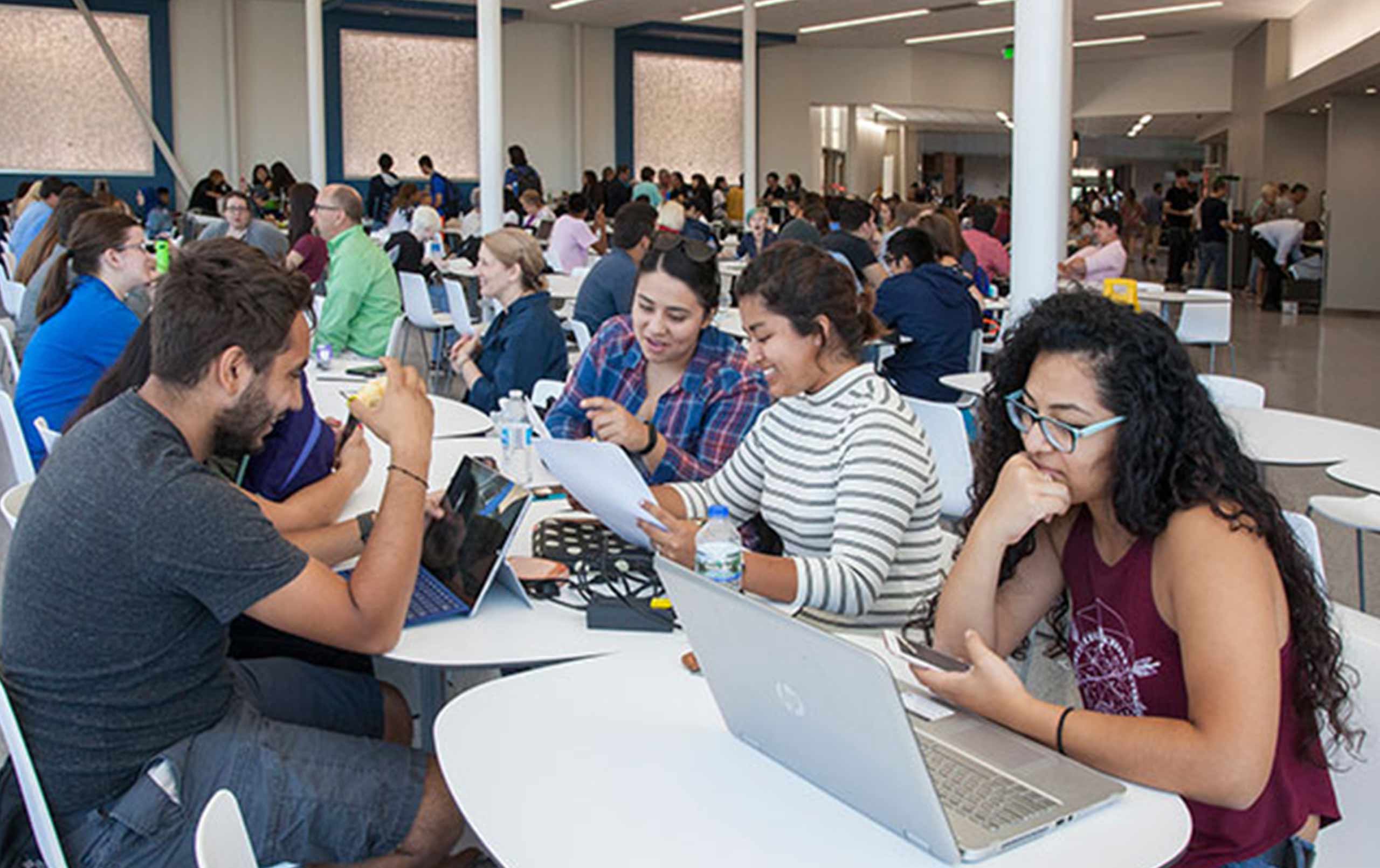
“Wow factor” drives design of additions and renovations to 45-year-old campus
[Grayslake, IL] – Dr. Patrick Peyer, dean of enrollment services at College of Lake County (CLC), recently walked a former student through the college’s renovated and expanded campus. It was the ultimate test: the student hadn’t been there in two years, so she was used to its hard-to-navigate corridors and dated look.
Among the many new sights that the student encountered were light-filled gathering spaces outfitted with contemporary furnishings and buzzing with students, expansive glass walls displaying once-hidden student programs, and a new café with organic food offerings, some of which were harvested from right there on campus.
At the end of the tour, the student said, “Wow! I have to enroll in a few more classes, and I have to tell my friends.”
Peyer said, “The wow factor is what we were looking for, and we got it.”
The project, designed by Legat Architects and built by Mortenson Construction, includes one addition: Café Willow, which sits above a new underground geothermal heating and cooling system. Renovations bring a revived Student Commons, a Welcome and One Stop Center, a Student Street, a new Student Resource Center, and the LancerZone Campus Store. The project, which started in May 2015 and finished in September 2016, finished on time and on budget. Cotter Consulting served as owner’s representative and program manager.
CLC President Dr. Jerry Weber said, “The primary goal we had was to centralize everything and create a more welcoming site for our students.”
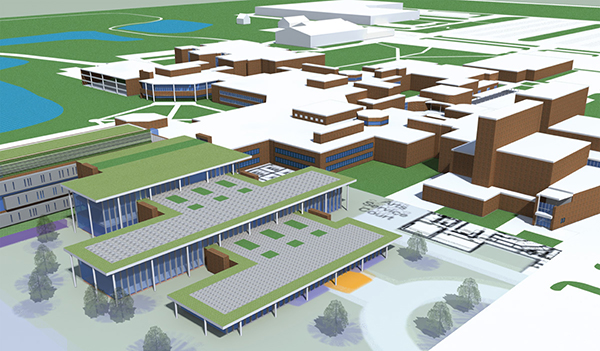
A Student-focused Process and Partnership
In 2012, CLC and long-time campus architect Legat completed a sustainable master plan to prepare the college for growth and improved energy efficiency over the next 20 years. The café addition and student life renovations are the first major phase of that master plan.
The CLC campus, which opened in 1969, had expanded over the decades, but it wasn’t tied together cohesively. Those who were not familiar with the campus had trouble getting around. Additionally, the campus core had only received minor upgrades since the campus opened.
Each department head offered input during planning. During construction, the college kept students, faculty, and board members informed with tours and weekly updates. The architect and construction manager also sent out weekly progress reports so there were no surprises.
Ken Gotsch, vice president for administrative affairs, said, “Throughout the project, there was a strong partnership between CLC, Legat, and Mortenson when it came to managing the day-to-day realities and not letting little things become big things.”
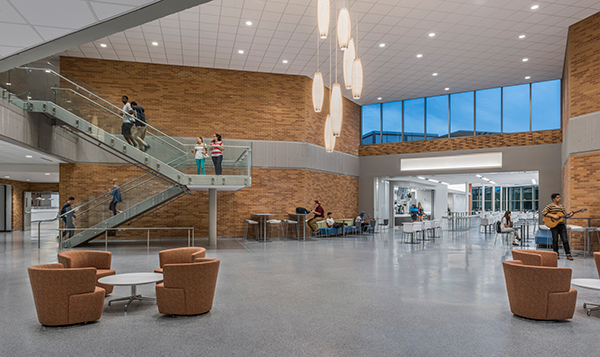
Student Commons: A Vibrant Campus Heart
For years, a bulky staircase blocked views to not only the one-story commons area, but also to the campus’s picturesque Willow Lake.
Mike Welch, director of facilities, said, “The commons, with its darker colors and low ceiling, still looked like something out of the ’70s. The main student hangout resembled a sunken living room.”
Today, that staircase is gone and a much less obstructive stair makes way for a spacious and light-filled Student Commons that Peyer called “a place for conversation and energy.”
Students on the second floor can look down into a bustling hub with comfortable furniture, a new café, and Willow Lake beyond. The commons also offers an IT Help Desk where students get free consulting services for computer fixes.
“The revived commons better unites the campus because it connects to the new Student Street and to other wings,” said Welch. “It’s one of the busiest places on campus.”
Assistant Director of Auxiliary Services Pat Argoudelis remembers the day the new furniture was installed in the Student Commons. “The furniture was supposed to be adjusted after installation,” she said, “but the installer couldn’t complete this until early the next morning because the students were already sitting on the furniture as soon as it was assembled!”
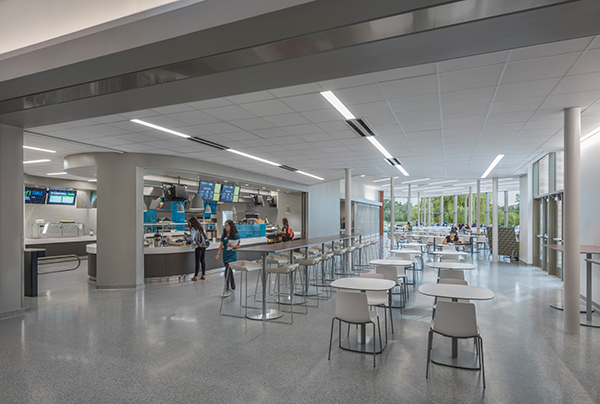
Café Willow: Fresh Foods and Stunning Views
For nearly 40 years, CLC’s cafeteria was on the basement level. Low ceilings and the absence of windows gave it a claustrophobic feel.
Now, Café Willow welcomes students with what Argoudelis calls “a bright and airy space to study and meet with friends.” Large windows fill the café with light and display Willow Lake. Not only has the college brought in a cutting-edge vendor that emphasizes organic foods, but the café also serves fresh vegetables from the Campus Learning Farm. It even offers honey extracted from on-campus beehives in the new apiary.
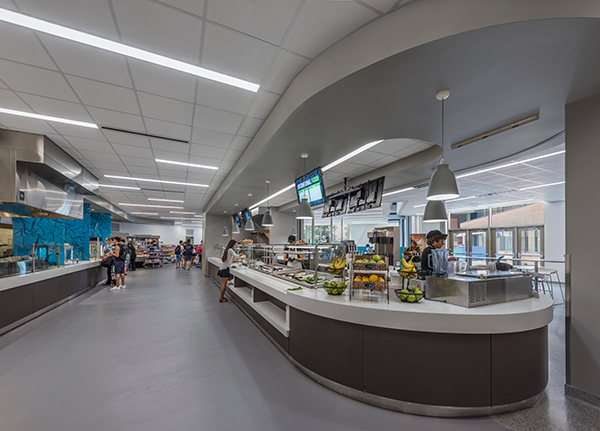
Argoudelis points out several additional Café Willow features that its predecessor was too small or ill-equipped to offer: handmade food, pre- and post-consumer composting, and interactive cooking, as well as the ability for CLC to provide in-house catering for campus events.
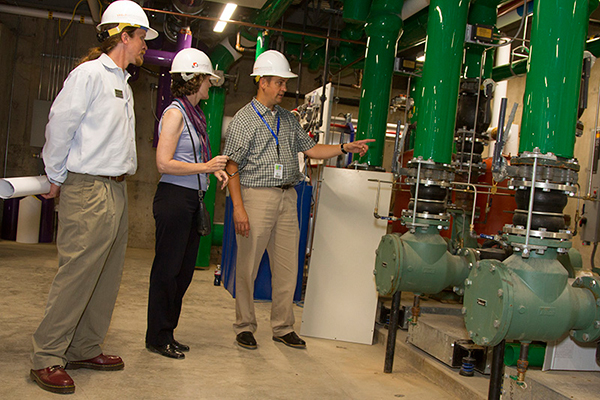
Energy-efficient Geothermal/Mechanical Systems
Buried deep beneath the café is evidence of the college’s commitment to sustainability: a “geothermal field” uses the earth’s constant temperature to help heat or cool the café, as well as the A and B wings.
President Jerry Weber says the campus is transforming into “a living laboratory.” Instructors use the geothermal system to support lessons in energy efficiency and sustainability.
Additionally, a new energy-efficient HVAC system housed on the basement level replaces a 30-year-old system to further reduce operational expenses.
These systems, part of many sustainable advancements at CLC, helped earn the college a 2016 Green Genome Award from the American Association of Community College. It was one of only nine colleges in the U.S. to receive the $10,000 award.
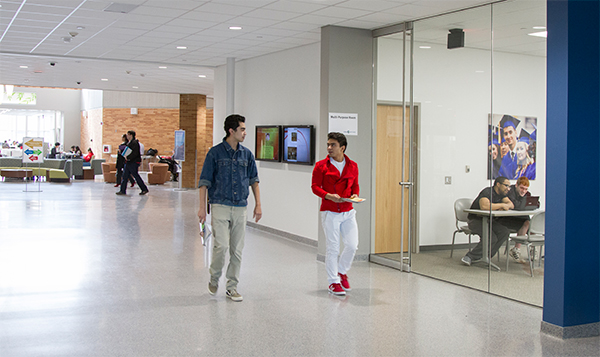
Student Street: The Path to Participation
Last year, only 200 students showed up in the old B Court for CLC’s Energize to Go! event, which encourages participation in the college’s 40+ clubs and organizations.
This year, the event took place in the new Student Street just off the commons. Over 800 students showed.
Before construction, many student organizations met in small, windowless classrooms tucked away in the basement. Welch said, “Other students wouldn’t see them or know about the exciting things our clubs and organizations are doing.”
The Student Street brings those activities to the forefront. It’s in a much more prominent location, plus its large glass walls exhibit to passing students not only the main student life offices, but also a large multipurpose space where student organizations meet.
In CLC’s student-run newspaper The Chronicle, Courtney Prais wrote, “I no longer feel as though these ominous ‘offices’ always talked about by professors and clubs are hidden away from us students; now, they are at the center of our attention.”
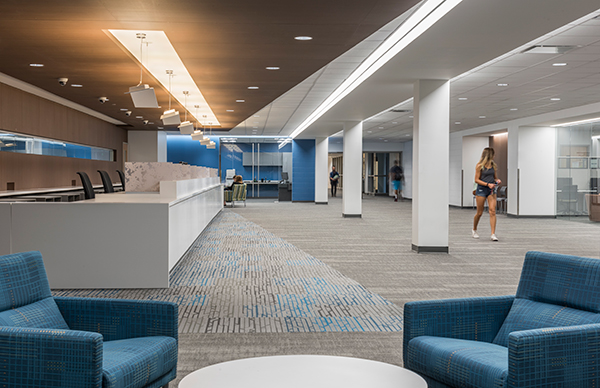
Welcome and One Stop Center: One Station, One Person
For years, CLC students did a lot of bouncing around and waiting in line at separate student service areas. The renovations eliminate that problem with a new Welcome and One Stop Center that consolidates at one station all major student service areas: Admissions and Recruitment, Registrar and Records, Financial Aid, and Advising and Counseling.
Students are greeted by front-line generalists cross-trained in each of those four divisions. If needed, front-line staff call in specialists from offices behind the main desk.
“A student coming in goes to one station and is greeted by one person,” said Peyer. “Serving all those needs at one front-line instead of four separate areas makes the student experience much more efficient and user-friendly.”
Another highlight of the One Stop and Welcome Center is a new glass-fronted recruitment office decorated with pennants from four-year institutions with guaranteed transfer programs.
A nearby area has new offices for the Counseling, Advising, and Transfer Center, as well as the Career and Job Placement Center.
Additionally, the Student Resource Center gets a new space right across from the One Stop and Welcome Center. Glass walls display the Multicultural Student Center, LGBTQ+ Resource Center, Women’s Center, and Veterans Service Center.
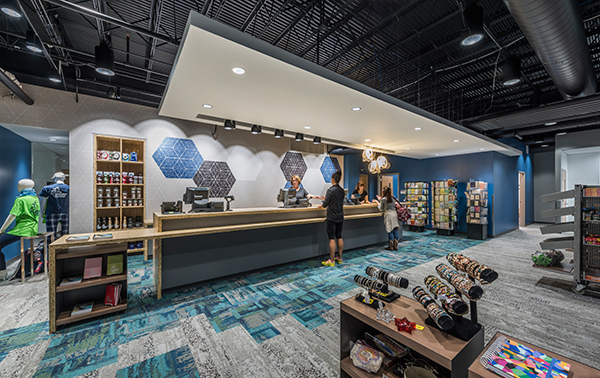
LancerZone Campus Store: A Spotlight on Spirit
Just off the commons, a large window displays another student-focused space: the LancerZone Campus Store. Renovations transformed an underused area into this CLC-branded retail store, formerly located on the basement level. LancerZone’s offerings range from school spirit wear and backpacks to snacks and gifts. It also carries electronics, with “try me” tables for laptops and tablets.
Argoudelis said, “The new location, along with the full glass front and spotlights that highlight our merchandise, has resulted in much higher traffic with students, faculty, and staff stopping in often.”
What’s Next?
The next phase of CLC’s student service-driven renovations has already begun. It features another student gathering area, as well as relocating the Testing Center and Office for Students with Disabilities to the campus core. The Center for International Education—CLC students represent 45 countries—has moved next to LancerZone.
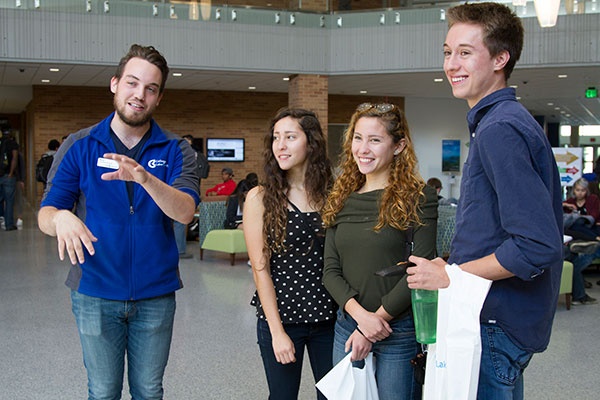
A Restored Heart
As Patrick Peyer reflected on his over 20 years of experience as a community college administrator, he said, “There’s a level of excitement and engagement that I’ve rarely seen. Other staff members talk about how the changes not only make it much easier to get around, but also enhance the comfort and make it easier to see and connect with students. It’s the heart of the campus that was missing for a while.”
One of the key measures of how effective that restored campus heart would be was students’ willingness to spend more time on campus. One such student is Courtney Prais. “What’s most interesting about these renovations,” she wrote in The Chronicle, “is how interconnected the campus seems to be this year. I have never seen more students in one spot than what I witness when I walk from class to class throughout the day and pass by the cafeteria area. I find myself wanting to spend more time with these fancy new amenities.”
Mission accomplished.
Contact us to learn more about higher education design, or comment below to share your thoughts on this post.
Photos courtesy College of Lake County and Connor Steinkamp, Steinkamp Photography.


